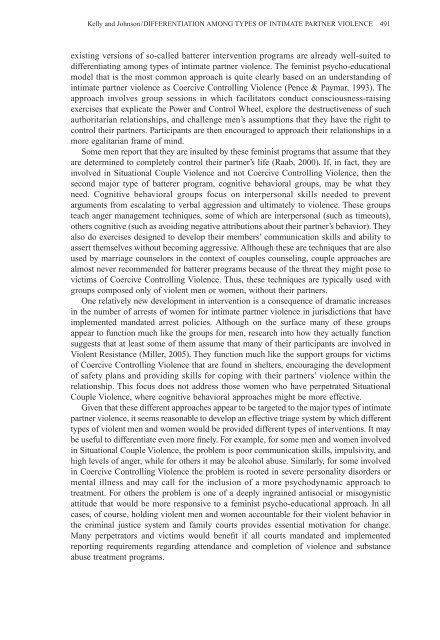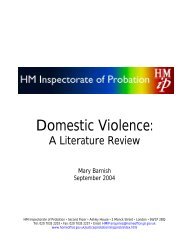differentiation among types of intimate partner violence - PAI Family ...
differentiation among types of intimate partner violence - PAI Family ...
differentiation among types of intimate partner violence - PAI Family ...
Create successful ePaper yourself
Turn your PDF publications into a flip-book with our unique Google optimized e-Paper software.
Kelly and Johnson/DIFFERENTIATION AMONG TYPES OF INTIMATE PARTNER VIOLENCE 491<br />
existing versions <strong>of</strong> so-called batterer intervention programs are already well-suited to<br />
differentiating <strong>among</strong> <strong>types</strong> <strong>of</strong> <strong>intimate</strong> <strong>partner</strong> <strong>violence</strong>. The feminist psycho-educational<br />
model that is the most common approach is quite clearly based on an understanding <strong>of</strong><br />
<strong>intimate</strong> <strong>partner</strong> <strong>violence</strong> as Coercive Controlling Violence (Pence & Paymar, 1993). The<br />
approach involves group sessions in which facilitators conduct consciousness-raising<br />
exercises that explicate the Power and Control Wheel, explore the destructiveness <strong>of</strong> such<br />
authoritarian relationships, and challenge men’s assumptions that they have the right to<br />
control their <strong>partner</strong>s. Participants are then encouraged to approach their relationships in a<br />
more egalitarian frame <strong>of</strong> mind.<br />
Some men report that they are insulted by these feminist programs that assume that they<br />
are determined to completely control their <strong>partner</strong>’s life (Raab, 2000). If, in fact, they are<br />
involved in Situational Couple Violence and not Coercive Controlling Violence, then the<br />
second major type <strong>of</strong> batterer program, cognitive behavioral groups, may be what they<br />
need. Cognitive behavioral groups focus on interpersonal skills needed to prevent<br />
arguments from escalating to verbal aggression and ultimately to <strong>violence</strong>. These groups<br />
teach anger management techniques, some <strong>of</strong> which are interpersonal (such as timeouts),<br />
others cognitive (such as avoiding negative attributions about their <strong>partner</strong>’s behavior). They<br />
also do exercises designed to develop their members’ communication skills and ability to<br />
assert themselves without becoming aggressive. Although these are techniques that are also<br />
used by marriage counselors in the context <strong>of</strong> couples counseling, couple approaches are<br />
almost never recommended for batterer programs because <strong>of</strong> the threat they might pose to<br />
victims <strong>of</strong> Coercive Controlling Violence. Thus, these techniques are typically used with<br />
groups composed only <strong>of</strong> violent men or women, without their <strong>partner</strong>s.<br />
One relatively new development in intervention is a consequence <strong>of</strong> dramatic increases<br />
in the number <strong>of</strong> arrests <strong>of</strong> women for <strong>intimate</strong> <strong>partner</strong> <strong>violence</strong> in jurisdictions that have<br />
implemented mandated arrest policies. Although on the surface many <strong>of</strong> these groups<br />
appear to function much like the groups for men, research into how they actually function<br />
suggests that at least some <strong>of</strong> them assume that many <strong>of</strong> their participants are involved in<br />
Violent Resistance (Miller, 2005). They function much like the support groups for victims<br />
<strong>of</strong> Coercive Controlling Violence that are found in shelters, encouraging the development<br />
<strong>of</strong> safety plans and providing skills for coping with their <strong>partner</strong>s’ <strong>violence</strong> within the<br />
relationship. This focus does not address those women who have perpetrated Situational<br />
Couple Violence, where cognitive behavioral approaches might be more effective.<br />
Given that these different approaches appear to be targeted to the major <strong>types</strong> <strong>of</strong> <strong>intimate</strong><br />
<strong>partner</strong> <strong>violence</strong>, it seems reasonable to develop an effective triage system by which different<br />
<strong>types</strong> <strong>of</strong> violent men and women would be provided different <strong>types</strong> <strong>of</strong> interventions. It may<br />
be useful to differentiate even more finely. For example, for some men and women involved<br />
in Situational Couple Violence, the problem is poor communication skills, impulsivity, and<br />
high levels <strong>of</strong> anger, while for others it may be alcohol abuse. Similarly, for some involved<br />
in Coercive Controlling Violence the problem is rooted in severe personality disorders or<br />
mental illness and may call for the inclusion <strong>of</strong> a more psychodynamic approach to<br />
treatment. For others the problem is one <strong>of</strong> a deeply ingrained antisocial or misogynistic<br />
attitude that would be more responsive to a feminist psycho-educational approach. In all<br />
cases, <strong>of</strong> course, holding violent men and women accountable for their violent behavior in<br />
the criminal justice system and family courts provides essential motivation for change.<br />
Many perpetrators and victims would benefit if all courts mandated and implemented<br />
reporting requirements regarding attendance and completion <strong>of</strong> <strong>violence</strong> and substance<br />
abuse treatment programs.



